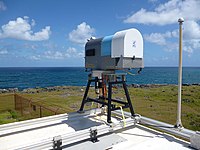
Photo from wikipedia
In this paper, a comprehensive review of portable microwave sensors for monitoring moisture content (MC) is presented. MC monitoring is crucial in different industries, particularly food and farming. Microwave-based approaches… Click to show full abstract
In this paper, a comprehensive review of portable microwave sensors for monitoring moisture content (MC) is presented. MC monitoring is crucial in different industries, particularly food and farming. Microwave-based approaches for measuring the MC of the grains and mineral materials are studied. These approaches are categorized into three groups: S-parameters, dielectric constant, and impedance measurements. While these methods are interrelated, they have differences. The investigated methods use different microwave antenna sensors for MC monitoring, such as coaxial probes, horn antennas, loop antennas, microstrip patch antennas, and frequency selective surface (FSS) antenna. State-of-the-art microwave sensors were investigated thoroughly to clarify the current challenges and possible solutions of MC monitoring. A comparison between the investigated sensors was made to determine their advantages and disadvantages. According to the comparison, sensors operating above 10 GHz suffer from cross-interference. Moreover, microstrip patches can monitor a wide MC range as extensive as 60%. At the same time, the FSS sensor has the highest sensitivity with an error as low as 0.023% at X-band. Microstrip patch and FSS antennas can be printed directly on a flexible, low-loss, and lightweight material to monitor the grain MC. The flexibility, compactness, portability, ease of environment-friendly fabrication, and high sensitivity are among the criteria determining the most suitable microwave sensors for industrial and consumer MC monitoring applications.
Journal Title: IEEE Access
Year Published: 2021
Link to full text (if available)
Share on Social Media: Sign Up to like & get
recommendations!